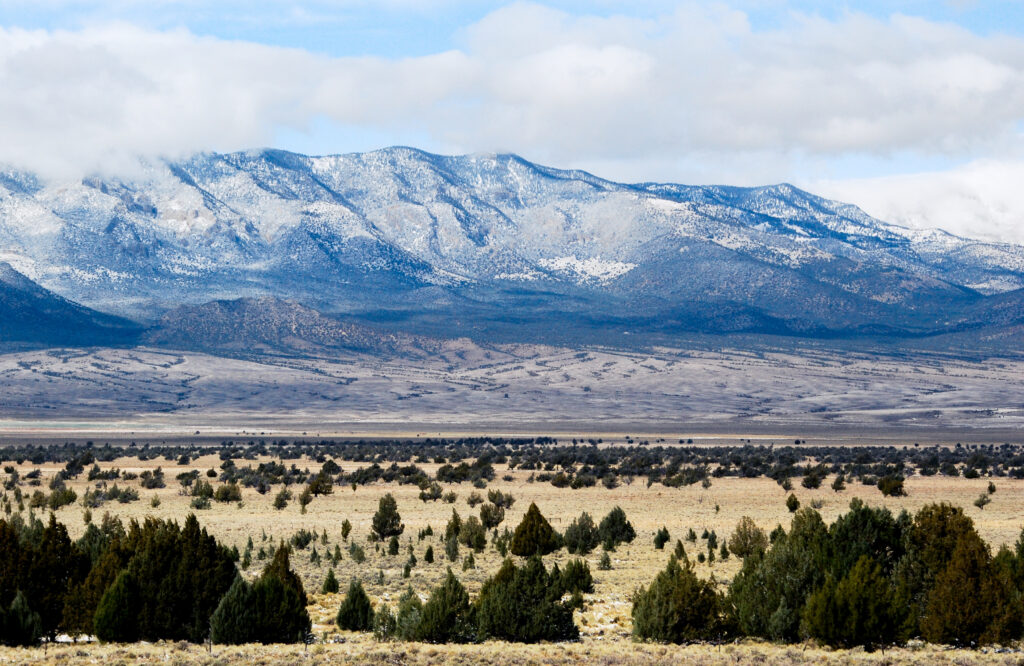The proposed Bahsahwahbee National Monument in White Pine County, Nevada. (Photo courtesy Kyle Roerink)
Several Native American Tribes in Nevada fear a new solar development plan created by the federal government could lead to utility scale solar developments on the site of the proposed Bahsahwahbee national monument.
Last week, the U.S. Bureau of Land Management released their long-anticipated Western Solar Plan, a roadmap that will set the trajectory for solar energy development across 11 western states for the next two decades.
Under the plan, about 12 million acres of public land in Nevada would be available for solar development. Utility scale solar developments would be permitted up to 15 miles from existing and planned transmission lines or designated energy corridors, as well as on previously disturbed lands.
The boundary of the proposed 25,000 acre Bahsahwahbee National Monument in White Pine County falls within those 15 miles.
Bahsahwahbee is the site of three 19th century massacres committed by settlers and the federal government against the Newe people — including one of the largest recorded massacres of Native Americans in U.S. history, resulting in the death of an estimated 525 to 700 men, women, and children. The sacred site is also home to an ecologically-unique grove of juniper trees where several Nevada Tribes still gather to connect with their ancestors, offer prayers, and hold healing ceremonies.
While the federal Western Solar Plan lists “traditional cultural properties and Native American sacred sites” as eligible criteria for exclusion from utility scale solar development, those sites would also need to be “recognized by the BLM.”
A portion of the proposed Bahsahwahbee national monument is listed on the National Register of Historic Places, but those protections are limited and only apply to a portion of the much larger cultural area.
The proposed national monument does enjoy broad support throughout Nevada, including a bill introduced by U.S. Sen. Catherine Cortez Masto to create the 25,000 acre national monument. A national monument can only be designated by Congress through legislation, or by the president through the Antiquities Act of 1906.
Without the ironclad protection of national monument status, Tribes in Nevada say they fear Bahsahwahbee could be targeted by solar developers under the federal plan.
“I am stunned and confused that while our Tribes are in discussions with the Biden-Harris Administration about establishing this monument, the BLM just issued a plan allowing the graves of our massacred ancestors to be bulldozed,” said Amos Murphy, the Chairman of the Confederated Tribes of the Goshute Reservation.
Under the Western Solar Plan, utility scale solar projects would still need to undergo the permitting process and environmental analysis before being approved. Part of that process requires consultation with Tribes, but Tribes in Nevada have been spurned by the BLM consultation process in recent construction projects on public land.
Cortez Masto’s office said the senator “is a strong supporter of Nevada’s growing solar energy economy, but not every location in Nevada is suitable for development.”
“Bahsahwahbee is sacred to numerous Tribal nations and until it is designated as a national monument, Senator Cortez Masto will continue to work with the Tribes and BLM to prevent disruptions to the area,” said Lauren Wodarski, a spokesperson for Cortez Masto.
The Ely Shoshone and the Confederated Tribes of the Goshute Reservation called on the Biden-Harris Administration to quickly designate Bahsahwahbee as a national monument within the National Park System, a call that’s been repeated for months.
“We need the Administration to support, not harm our Tribes, and that means swiftly preserving and commemorating this area at the highest level: our National Park System,” Murphy said.
If Bahsahwahbee became a monument, the land would transfer to the National Park Service, where it would be managed in cooperation with the Ely Shoshone Tribe, the Duckwater Shoshone Tribe, and the Confederated Tribes of the Goshute Reservation.
“Our Tribes don’t want to keep fighting, but we will do whatever is necessary to protect our ancestors and culture from threats,” said Alvin Marques, the Chairman of the Ely Shoshone Tribe. “It’s time for the Biden-Harris Administration to once and for all turn the page to a brighter future and establish this monument.”
Monte Sanford, the Bahsawhabee National Monument campaign’s director, said the inclusion of public land in the proposed national monument is “a bit baffling.”
“I think that sends a lot of mixed signals to not just tribes, but to the public who want these places protected,” Stanford said. “They know there’s a monument effort.”
“This just goes to show that action by the administration is needed now,” he continued.
Under the Western Solar Plan, about 35 million acres of public land with high conflict potential in Nevada would be excluded from solar development.
The plan is now open for a 30-day administrative protest period, during which people and groups that have already commented on the plan can raise concerns. Governors within the 11-state planning area also have up to 60-days to identify inconsistencies with approved state or local plans, policies, or programs and to provide written recommendations to the BLM.

